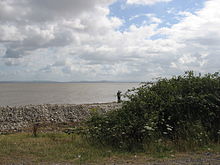| Site of Special Scientific Interest | |
 Bridgwater Bay near the mouth of the River Parrett | |
| Location | Somerset |
|---|---|
| Grid reference | ST290480 |
| Coordinates | 51°15′N 3°12′W / 51.25°N 3.20°W |
| Interest | Biological |
| Area | 3,574.1 ha (35.741 km2; 13.800 sq mi) |
| Notification | 1989 |
| Natural England website | |
Bridgwater Bay is on the Bristol Channel, 5 kilometres (3.1 mi) north of Bridgwater in Somerset, England at the mouth of the River Parrett and the end of the River Parrett Trail. It stretches from Minehead at the southwestern end of the bay to Brean Down in the north. The area consists of large areas of mudflats, saltmarsh, sandflats and shingle ridges, some of which are vegetated. It has been designated as a Site of Special Scientific Interest (SSSI) covering an area of 3,574.1 hectares (35.741 km2; 13.800 sq mi)[1] since 1989,[2] and is designated as a wetland of international importance under the Ramsar Convention.[3] The risks to wildlife are highlighted in the local Oil Spill Contingency Plan.[4]
Several rivers, including the Parrett, Brue and Washford, drain into the bay. Man-made drainage ditches from the Somerset Levels, including the River Huntspill, also run into the bay. The mud flats provide a habitat for a wide range of flora and fauna. These include some nationally rare plants, beetles and snails. It is particularly important for overwintering waders and wildfowl, with approximately 190 species recorded including Eurasian whimbrel (Numenius phaeopus), black-tailed godwit (Limosa limosa), dunlin (Calidris alpina) and wigeon (Anas penelope). Fishing has taken place using shallow boats, known as flatners, and fixed wooden structures for hundreds of years. It was also the last site in England used for 'mudhorse fishing'. There are several small harbours along the coast.
The low-lying areas of the bay have been subject to flooding, including the Bristol Channel floods of 1607 and many times since particularly around the Steart Peninsula. In response to this threat sea walls have been built at several points including at Burnham-on-Sea, Berrow and Blue Anchor to Lilstock Coast. The extensive mud flats and high tidal range have been the cause of several drownings and rescue services are now provided by the Burnham Area Rescue Boat.
- ^ "Bridgwater Bay SSSI". Natural England. Retrieved 7 January 2017.
- ^ "SSSI citation sheet" (PDF). Sites of Special Scientific Interest. English Nature. Archived from the original (PDF) on 10 September 2008. Retrieved 12 November 2008.
- ^ "Bridgwater Bay NNR". National Nature Reserves. Natural England. Archived from the original on 26 May 2015. Retrieved 27 January 2017.
- ^ "Oil spill contingency plan". Sedgemoor Council. Archived from the original on 3 June 2011. Retrieved 13 November 2008.

